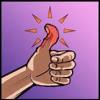I have had Woodjoy round spoke shave for years. Every year or so I drag it out and try to get an edge that will work on hard woods. These woods would be maple, cherry and walnut.
I can get curly fine shavings from pine but then it all goes down hill with, at this time, cherry. It chatters and tears in places. I have it set to a very fine cut but it is still not sharp enough.
I have spent an untold amount of time trying to get it sharp but I just as well be spitting into the wind.
The fists water stone I use is an 800 then onto a Shapton 8000. This works well for my planes and chisels but not the little shave blade.
Any pointers?





 Reply With Quote
Reply With Quote





